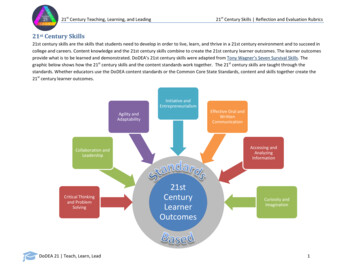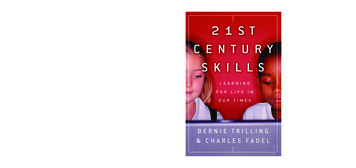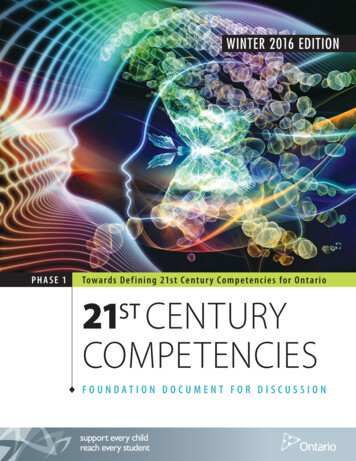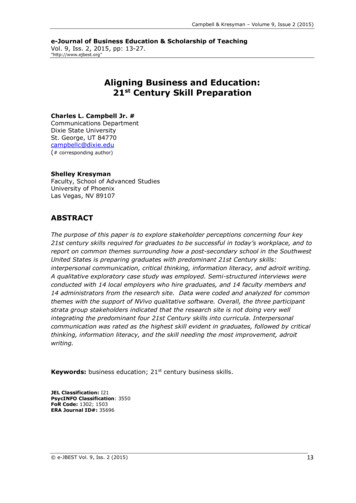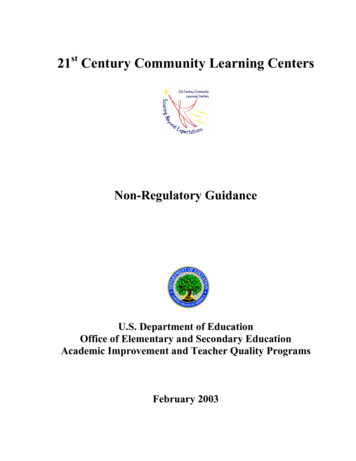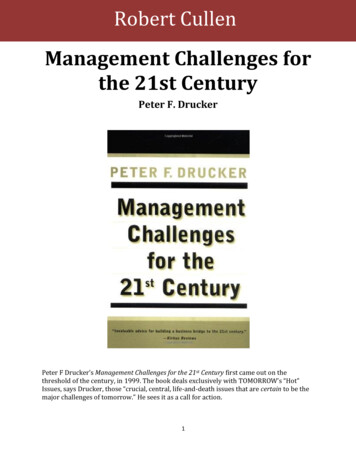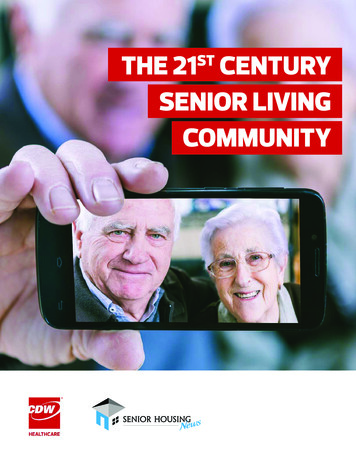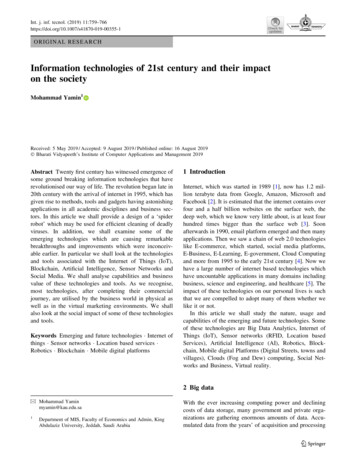
Transcription
Int. j. inf. tecnol. (2019) 55-1ORIGINAL RESEARCHInformation technologies of 21st century and their impacton the societyMohammad Yamin1Received: 5 May 2019 / Accepted: 9 August 2019 / Published online: 16 August 2019Ó Bharati Vidyapeeth’s Institute of Computer Applications and Management 2019Abstract Twenty first century has witnessed emergence ofsome ground breaking information technologies that haverevolutionised our way of life. The revolution began late in20th century with the arrival of internet in 1995, which hasgiven rise to methods, tools and gadgets having astonishingapplications in all academic disciplines and business sectors. In this article we shall provide a design of a ‘spiderrobot’ which may be used for efficient cleaning of deadlyviruses. In addition, we shall examine some of theemerging technologies which are causing remarkablebreakthroughs and improvements which were inconceivable earlier. In particular we shall look at the technologiesand tools associated with the Internet of Things (IoT),Blockchain, Artificial Intelligence, Sensor Networks andSocial Media. We shall analyse capabilities and businessvalue of these technologies and tools. As we recognise,most technologies, after completing their commercialjourney, are utilised by the business world in physical aswell as in the virtual marketing environments. We shallalso look at the social impact of some of these technologiesand tools.Keywords Emerging and future technologies Internet ofthings Sensor networks Location based services Robotics Blockchain Mobile digital platforms1 IntroductionInternet, which was started in 1989 [1], now has 1.2 million terabyte data from Google, Amazon, Microsoft andFacebook [2]. It is estimated that the internet contains overfour and a half billion websites on the surface web, thedeep web, which we know very little about, is at least fourhundred times bigger than the surface web [3]. Soonafterwards in 1990, email platform emerged and then manyapplications. Then we saw a chain of web 2.0 technologieslike E-commerce, which started, social media platforms,E-Business, E-Learning, E-government, Cloud Computingand more from 1995 to the early 21st century [4]. Now wehave a large number of internet based technologies whichhave uncountable applications in many domains includingbusiness, science and engineering, and healthcare [5]. Theimpact of these technologies on our personal lives is suchthat we are compelled to adopt many of them whether welike it or not.In this article we shall study the nature, usage andcapabilities of the emerging and future technologies. Someof these technologies are Big Data Analytics, Internet ofThings (IoT), Sensor networks (RFID, Location basedServices), Artificial Intelligence (AI), Robotics, Blockchain, Mobile digital Platforms (Digital Streets, towns andvillages), Clouds (Fog and Dew) computing, Social Networks and Business, Virtual reality.2 Big data& Mohammad Yaminmyamin@kau.edu.sa1Department of MIS, Faculty of Economics and Admin, KingAbdulaziz University, Jeddah, Saudi ArabiaWith the ever increasing computing power and decliningcosts of data storage, many government and private organizations are gathering enormous amounts of data. Accumulated data from the years’ of acquisition and processing123
760in many organizations has become enormous meaning thatit can no longer be analyzed by traditional tools within areasonable time. Familiar disciplines to create Big datainclude astronomy, atmospheric science, biology, genomics, nuclear physics, biochemical experiments, medicalrecords, and scientific research. Some of the organizationsresponsible to create enormous data are Google, Facebook,YouTube, hospitals, proceedings of parliaments, courts,newspapers and magazines, and government departments.Because of its size, analysis of big data is not a straightforward task and often requires advanced methods andtechniques. Lack of timely analysis of big data in certaindomains may have devastating results and pose threats tosocieties, nature and echo system.2.1 Big medic dataHealthcare field is generating big data, which has thepotential to surpass other fields when it come to the growthof data. Big Medic data usually refers to considerablybigger pool of health, hospital and treatment records,medical claims of administrative nature, and data fromclinical trials, smartphone applications, wearable devicessuch as RFID and heart beat reading devices, differentkinds of social media, and omics-research. In particularomics-research (genomics, proteomics, metabolomics etc.)is leading the charge to the growth of Big data [6, 7]. Thechallenges in omics-research are data cleaning, normalization, biomolecule identification, data dimensionalityreduction, biological contextualization, statistical validation, data storage and handling, sharing and data archiving.Data analytics requirements include several tasks like thoseof data cleaning, normalization, biomolecule identification,data dimensionality reduction, biological contextualization,statistical validation, data storage and handling, sharingand data archiving. These tasks are required for the Bigdata in some of the omics datasets like genomics, transcriptomics, proteomics, metabolomics, metagenomics,phenomics [6].According to [8], in 2011 alone, the data in the UnitedStates of America healthcare system amounted to onehundred and fifty Exabyte (One Exabyte One billionGigabytes, or 1018 Bytes), and is expected soon reach to1021 and later 1024. Some scientist have classified Medicalinto three categories having (a) large number of samplesbut small number of parameters; (b) small number ofsamples and small number of parameters; (c) large smallnumber of samples and small number of parameters [9].Although the data in the first category may be analyzed byclassical methods but it may be incomplete, noisy, andinconsistent, data cleaning. The data in the third categorycould be big and may require advanced analytics.123Int. j. inf. tecnol. (2019) 11:759–7662.2 Big data analyticsBig data cannot be analyzed in real time by traditionalanalytical methods. The analysis of Big data, popularlyknown as Big Data Analytics, often involves a number oftechnologies, sophisticated processes and tools as depictedin Fig. 1. Big data can provide smart decision making andbusiness intelligence to the businesses and corporations.Big data unless analyzed is impractical and a burden to theorganization. Big data analytics involves mining andextracting useful associations (knowledge discovery) forintelligent decision-making and forecasts. The challengesin Big Data analytics are computational complexities,scalability and visualization of data. Consequently, theinformation security risk increases with the surge in theamount of data, which is the case in Big Data.The aim of data analytics has always been knowledgediscovery to support smart and timely decision making. Withbig data, knowledge base becomes widened and sharper toprovide greater business intelligence and assist businesses inbecoming a leader in the market. Conventional processingparadigm and architecture are inefficient to deal with thelarge datasets from the Big data. Some of the problems of BigData are to deal with the size of data sets in Big Data,requiring parallel processing. Some of the recent technologies like Spark, Hadoop, Map Reduce, R, Data Lakes andNoSQL have emerged to provide Big Data analytics. With allthese and other data analytics technologies, it is advantageous to invest in designing superior storage systems.Health data predominantly consists of visual, graphs,audio and video data. Analysing such data to gain meaningful insights and diagnoses may depend on the choice oftools. Medical data has traditionally been scattered in theorganization, often not organized properly. What we findusually are medical record keeping systems which consist ofheterogeneous data, requiring more efforts to reorganize thedata into a common platform. As discussed before, the healthprofession produces enormous data and so analysing it in anefficient and timely manner can potentially save many lives.3 CloudsCommercial operations of Clouds from the company platforms began in the year 1999 [10]. Initially, clouds complemented and empowered outsourcing. At earlier stages,there were some privacy concerns associated with CloudComputing as the owners of data had to give the custody oftheir data to the Cloud owners. However, as time passed,with confidence building measures by Cloud owners, thetechnology became so prevalent that most of the world’sSMEs started using it in one or the other form. Moreinformation on Cloud Computing can be found in [11, 12].
Int. j. inf. tecnol. (2019) 11:759–766761Fig. 1 Big Data Analytics3.1 Fog computingAs faster processing became the need for some criticalapplications, the clouds regenerated Fog or Edge computing. As can be seen in Gartner hyper cycles in Figs. 2 and3, Edge computing, as an emerging technology, has alsopeaked in 2017–18. As shown in the Cloud Computingarchitecture in Fig. 4, the middle or second layers of thecloud configuration are represented by the Fog computing.For some applications delay in communication between thecomputing devices in the field and data in a Cloud (oftenphysically apart by thousands of miles), is detrimental ofthe time requirements, as it may cause considerable delayin time sensitive applications. For example, processing andstorage for early warning of disasters (stampedes, Tsunami,etc.) must be in real time. For these kinds of applications,computing and storing resources should be placed closer towhere computing is needed (application areas like digitalFig. 2 Emerging Technologies 2018123
762Int. j. inf. tecnol. (2019) 11:759–766Fig. 3 Emerging Technologies 2017Fig. 5 Snapshot of a Ubiquitous SystemFig. 4 Relationship of Cloud, Fog and Dew computingstreet). In these kind of scenarios Fog computing is considered to be suitable [13]. Clouds are integral part of manyIoT applications and play central role on ubiquitous computing systems in health related cases like the one depictedin Fig. 5. Some applications of Fog computing can befound in [14–16]. More results on Fog computing are alsoavailable in [17–19].3.2 Dew computingWhen Fog is overloaded and is not able to cater for thepeaks of high demand applications, it offloads some of itsdata and/or processing to the associated cloud. In such asituation, Fog exposes its dependency to a complementary123bottom layer of the cloud architectural organisation asshown in the Cloud architecture of Fig. 4. This bottomlayer of hierarchical resources organization is known as theDew layer. The purpose of the Dew layer is to cater for thetasks by exploiting resources near to the end-user withminimum internet access [17, 20]. As a feature, Dewcomputing takes care of determining as to when to use forits services linking with the different layers of the Cloudarchitecture. It is also important to note that the Dewcomputing [20] is associated with the distributed computing hierarchy and is integrated by the Fog computing services, which is also evident in Fig. 4. In summary, Cloudarchitecture has three layers, first being Cloud, second asFog and the third Dew.
Int. j. inf. tecnol. (2019) 11:759–7667634 Internet of things5 Applications of blockchainDefinition of Internet of Things (IoT), as depicted in Fig. 6,has been changing with the passage of time. With growingnumber of internet based applications, which use manytechnologies, devices and tools, one would think, the nameof IoT seems to have evolved. Accordingly, things (technologies, devices and tools) used together in internet basedapplications to generate data to provide assistance andservices to the users from anywhere, at any time. Theinternet can be considered as a uniform technology fromany location as it provides the same service of ‘connectivity’. The speed and security however are not uniform.The IoT as an emerging technology has peaked during2017–18 as is evident from Figs. 2 and 3. This technologyis expanding at a very fast rate. According to [21–24], thenumber of IoT devices could be in millions by the year2021.IoT is providing some amazing applications in tandemwith wearable devices, sensor networks, Fog computing,and other technologies to improve some the critical facetsof our lives like healthcare management, service delivery,and business improvements. Some applications of IoT inthe field of crowd management are discussed in [14]. Someapplications in of IoT in the context of privacy and securityare discussed in [15, 16]. Some of the key devices andassociated technologies to IoT include RFID Tags [25],Internet, computers, cameras, RFID, Mobile Devices,coloured lights, RFIDs, Sensors, Sensor networks, Drones,Cloud, Fog and Dew.Blockchain is usually associated with Cryptocurrencieslike Bitcoin (Currently, there are over one and a halfthousand cryptocurrencies and the numbers are still rising).But the Blockchain technology can also be used for manymore critical applications of our daily lives. The Blockchain is a distributed ledger technology in the form of adistributed transactional database, secured by cryptography, and governed by a consensus mechanism.A Blockchain is essentially a record of digital events [26].A block represents a completed transaction or ledger.Subsequent and prior blocks are chained together, displaying the status of the most recent transaction. The roleof chain is to provide linkage between records in achronological order. This chain continues to grow as andwhen further transactions take place, which are recorded byadding new blocks to the chain. User security and ledgerconsistency in the Blockchain is provided by Asymmetriccryptography and distributed consensus algorithms. Once ablock is created, it cannot be altered or removed. Thetechnology eliminates the need for having a bank statementfor verification of the availability of funds or that of alawyer for certifying the occurrence of an event. Thebenefits of Blockchain technology are inherited in itscharacteristics of decentralization, persistency, anonymityand auditability [27, 28].5.1 Blockchain for business useBlockchain, being the technology behind Cryptocurrencies,started as an open-source Bitcoin community to allowreliable peer-to-peer financial transactions. BlockchainFig. 6 Internet of Things123
764technology has made it possible to build a globally functional currency relying on code, without using any bank orthird-party platforms [28]. These features have made theBlockchain technology, secure and transparent for businesstransactions of any kind involving any currencies. In literature, we find many applications of Blockchain. Nowadays, the applications of Blockchain technology involvevarious kinds of transactions requiring verification andautomated system of payments using smart contracts. Theconcept of Smart Contacts [28] has virtually eliminated therole of intermediaries. This technology is most suitable forbusinesses requiring high reliability and honesty. Becauseof its security and transparency features, the technologywould benefit businesses trying to attract customers.Blockchain can be used to eliminate the occurrence of fakepermits as can be seen in [29].5.2 Blockchain for healthcare managementAs discussed above, Blockchain is an efficient and transparent way of digital record keeping. This feature is highlydesirable in efficient healthcare management. Medical fieldis still undergoing to manage their data efficiently in adigital form. As usual the issues of disparate and nonuniform record storage methods are hampering the digitization, data warehouse and big data analytics, which wouldallow efficient management and sharing of the data. Welearn the magnitude of these problem from examples ofsuch as the target of the National Health Service (NHS) ofthe United Kingdom to digitize the UK healthcare is by2023 [30]. These problems lead to inaccuracies of datawhich can cause many issues in healthcare management,including clinical and administrative errors.Use of Blockchain in healthcare can bring revolutionaryimprovements. For example, smart contracts can be used tomake it easier for doctors to access patients’ data fromother organisations. The current consent process ofteninvolves bureaucratic processes and is far from beingsimplified or standardised. This adds to many problems topatients and specialists treating them. The cost associatedwith the transfer of medical records between differentlocations can be significant, which can virtually be reducedto zero by using Blockchain. More information on the useof Blockchain in the healthcare data can be found in[30, 31].6 Environment cleaning robotOne of the ongoing healthcare issue is the eradication ofdeadly viruses and bacteria from hospitals and healthcareunits. Nosocomial infections are a common problem forhospitals and currently they are treated using various123Int. j. inf. tecnol. (2019) 11:759–766techniques [32, 33]. Historically, cleaning the hospitalwards and operating rooms with chlorine has been aneffective way. On the face of some deadly viruses likeEBOLA, HIV Aids, Swine Influenza H1N1, H1N2, variousstrands of flu, Severe Acute Respiratory Syndrome (SARS)and Middle Eastern Respiratory Syndrome (MERS), thereare dangerous implications of using this method [14]. Anadvanced approach is being used in the USA hospitals,which employs ‘‘robots’’ to purify the space as can be seenin [32, 33]. However, certain problems exist within thelimitations of the current ‘‘robots’’. Most of these devicesrequire a human to place them in the infected areas. Thesedevices cannot move effectively (they just revolve aroundthemselves); hence, the UV light will not reach all areasbut only a very limited area within the range of the UVlight emitter. Finally, the robot itself maybe infected as thelight does not reach most of the robot’s surfaces. Therefore,there is an emerging need to build a robot that would notrequire the physical presence of humans to handle it, andcould purify the entire room by covering all the roomsurfaces with UV light while, at the same time, will not beinfected itself.Figure 7 is an overview of the design of a fully motorized spider robot with six legs. This robot supports Wi-Ficonnectivity for the purpose of control and be able to movearound the room and clean the entire area. The spiderdesign will allow the robot to move in any surface,including climbing steps but most importantly the robotwill use its legs to move the UV light emitter as well asclear its body before leaving the room. This substantiallyreduces the risk of the robot transmitting any infections.Additionally, the robot will be equipped with a motorized camera allowing the operator to monitor space andstop the process of emitting UV light in case of unpredictedsituations. The operator can control the robot via a networked graphical user interface and/or from an augmentedreality environment which will utilize technologies such asthe Oculus Touch. In more detail, the user will use theoculus rift virtual reality helmet and the oculus touch, aswell as hand controllers to remote control the robot. Thiswill provide the user with the vision of the robot in anatural manner. It will also allow the user to control thetwo front robotic arms of the spider robot via the oculustouch controller, making it easy to do conduct advancemovements, simply by move the hands. The physicalmovements of the human hand will be captured by thesensors of oculus touch and transmitted to the robot. Therobot will then use reverse kinematics to translate theactions and position of the human hand to movements ofthe robotic arm. This technique will also be used during thetraining phase of the robot, where the human user willteach the robot how to clean various surfaces and thenpurify itself, simply by moving their hands accordingly.
Int. j. inf. tecnol. (2019) 11:759–766765Fig. 7 Spider Robot for viruscleaningThe design of the spider robot was proposed in a projectproposal submitted to the King Abdulaziz City of Scienceand Technology (https://www.kacst.edu.sa/eng/Pages/default.aspx) by the author and George Tsaramirsis (https://www.researchgate.net/profile/George Tsaramirsis).7 ConclusionsWe have presented details of some of the emerging technologies and real life application, that are providing businesses remarkable opportunities, which were previouslyunthinkable. Businesses are continuously trying to increasethe use of new technologies and tools to improve processes,to benefit their client. The IoT and associated technologiesare now able to provide real time and ubiquitous processingto eliminate the need for human surveillance. Similarly,Virtual Reality, Artificial Intelligence robotics are havingsome remarkable applications in the field of medicalsurgeries. As discussed, with the help of the technology, wenow can predict and mitigate some natural disasters such asstampedes with the help of sensor networks and otherassociated technologies. Finally, the increase in Big DataAnalytics is influencing businesses and government agencies with smarter decision making to achieve targets orexpectations.References1. Naughton John (2016) The evolution of the internet: from military experiment to general purpose technology. J Cyber Policy1(1):5–28. https://doi.org/10.1080/23738871.2016.11576192. Gareth Mitchell (2019). How much data is on the internet? Science Focus (The Home of BBC Science Focus Magazine). ology/howmuch-data-is-on-the-internet/. Accessed 20 April 20193. Mae Rice (2018). The deep web is the 99% of the internet youcan’t google. Curiosity. [Online]. ed 20 April 20194. Slumkoski C (2012) History on the internet 2.0: the rise of socialmedia. Acadiensis 41(2):153–162 (Summer/Autumn-ÉTÉ/Automne)5. Ibarra-Esquer JE, González-Navarro FF, Flores-Rios BL, Burtseva L, Marı́a A, Astorga-Vargas M (2017) Tracking the evolution of the internet of things concept across different applicationdomains. Sensors (Basel) 17(6):1379. https://doi.org/10.3390/s170613796. Misra Biswapriya B, Langefeld Carl, Olivier Michael, Cox LauraA (2018) Integrated omics: tools, advances and future approaches. J Mol Endocrinol 62(1):R21–R45. https://doi.org/10.1530/JME-18-00557. Lee Choong Ho, Yoon Hyung-Jin (2017) Medical big data:promise and challenges. Kidney Res Clin Practice 36.1.38. Faggella D (2019). Where healthcare’s big data actually comesfrom. Emerj. [Onlone]. Last accessed from ares-big-data-actually-comesfrom/9. Sinha A, Hripcsak G, Markatou M (2009) Large datasets inbiomedicine: a discussion of salient analytic issues. J Am MedInform Assoc 16:759–767. https://doi.org/10.1197/jamia.M2780123
76610. Keith D. Foote a brief history of cloud computing. DATAVERSITY, 2017. {Online]. Last accessed on 5/5/2019 from ABrief History of Cloud Computing11. Vassakis K, Petrakis E, Kopanakis I (2018) Big data analytics:applications, prospects and challenges. In: Skourletopoulos G,Mastorakis G, Mavromoustakis C, Dobre C, Pallis E (eds) Mobilebig data. Lecture notes on data engineering and communicationstechnologies, vol 10. Springer, Cham12. Yamin M, Al Makrami AA (2015) Cloud computing in SMEs:case of Saudi Arabia. BIJIT—BVICAM’s Int J Inform Technol7(1):853–86013. Ahmed E, Ahmed A, Yaqoob I, Shuja J, Gani A, Imran M,Shoaib M (2017) Bringing computation closer toward the usernetwork: is edge computing the solution? IEEE Commun Mag55:138–14414. Yamin M, Basahel AM, Abi Sen AA (2018) Managing crowdswith wireless and mobile technologies. Hindawi. WirelessCommun Mobile Comput. Volume 2018, Article ID 7361597,pp 15. https://doi.org/10.1155/2018/736159715. Yamin M, Abi Sen AA (2018) Improving privacy and security ofuser data in location based services. Int J Ambient Comput Intell9(1):19–42. https://doi.org/10.4018/IJACI.201801010216. Sen AAA, Eassa FA, Jambi K, Yamin M (2018) Preservingprivacy in internet of things—a survey. Int J Inform Technol10(2):189–200. https://doi.org/10.1007/s41870-018-0113-417. Longo Mathias, Hirsch Matı́as, Mateos Cristian, Zunino Alejandro (2019) Towards integrating mobile devices into dew computing: a model for hour-wise prediction of energy availability.Information 10(3):86. https://doi.org/10.3390/info1003008618. Nunna S, Kousaridas A, Ibrahim M, Dillinger M, Thuemmler C,Feussner H, Schneider A Enabling real-time context-aware collaboration through 5G and mobile edge computing. In: Proceedings of the 12th international conference on informationtechnology-new generations, Las Vegas, NV, USA, 13–15 April2015; pp 601–60519. Vaquero LM, Rodero-Merino L (2014) Finding your way in thefog: towards a comprehensive definition of fog computing.SIGCOMM Comput Commun Rev 44:27–3220. Ray PP (2019) Minimizing dependency on internetwork: Is dewcomputing a solution? Trans Emerg Telecommun Technol30:e349621. Bonomi F, Milito R, Zhu J, Addepalli S Fog computing and itsrole in the internet of things. In: Proceedings of the first edition ofthe workshop on mobile cloud computing, Helsinki, Finland, 17August 2012; pp 13–16. [Google Scholar]123Int. j. inf. tecnol. (2019) 11:759–76622. Jia X, Feng Q, Fan T, Lei Q, RFID technology and its applications in internet of things (IoT), consumer electronics, communications and networks (CECNet). In: 2nd internationalconference proceedings, pp 1282–1285. IEEE, 2012, https://doi.org/10.1109/cecnet.2012.620150823. Said O, Masud M (2013) Towards internet of things: survey andfuture vision. Int J Comput Netw 5(1):1–1724. Gubbi J, Buyya R, Marusic S, Palaniswami M (2013) Internet ofthings (IoT): a vision, architectural elements, and future directions. Future Gener Comput Syst 29(7):1645–1660. https://doi.org/10.1016/j.future.2013.01.01025. Beck R, Avital M, Rossi M et al (2017) Blockchain technology inbusiness and information systems research. Bus Inf Syst Eng59:381. https://doi.org/10.1007/s12599-017-0505-126. Yamin M (2018) Managing crowds with technology: cases ofHajj and Kumbh Mela. Int J Inform Technol. https://doi.org/10.1007/s41870-018-0266-127. Zheng Z, Xie S, Dai H, Chen X, Wang H An overview ofblockchain technology: architecture, consensus, and future 8131748 An Overview of Blockchain Technology Architecture Consensus andFuture Trends. Accessed May 01 201928. Al-Saqafa W, Seidler N (2017) Blockchain technology for socialimpact: opportunities and challenges ahead. J Cyber Secur 8429. Alotaibi M, Alsaigh M, Yamin M (2019) Blockchain for controlling Hajj and Umrah permits. Int J Comput Sci Netw Secur19(4):69–7730. Vazirani AA, O’Donoghue O, Brindley D (2019) Implementingblockchains for efficient health care: systematic review. J MedInternet Res 21(2):12439. https://doi.org/10.2196/1243931. Yamin M (2018) IT applications in healthcare management: asurvey. Int J Inform Technol 10(4):503–509. https://doi.org/10.1007/s41870-018-0203-332. Begić A. (2018) Application of Service Robots for Disinfectionin Medical Institutions. In: Hadžikadić M., Avdaković S. (eds)Advanced Technologies, Systems, and Applications II. IAT(2017) Lecture Notes in Networks and Systems, vol 28. Springer,Cham33. Mettler T, Sprenger M, Winter R (2017) Service robots in hospitals: new perspectives on niche evolution and technologyaffordances. Euro J Inform Syst. 10:11. https://doi.org/10.1057/s41303-017-0046-1
could be big and may require advanced analytics. 2.2 Big data analytics Big data cannot be analyzed in real time by traditional analytical methods. The analysis of Big data, popularly known as Big Data Analytics, often involves a number of technologies, sophisticated processes and tools as depicted in Fig. 1. Big data can provide smart decision .
